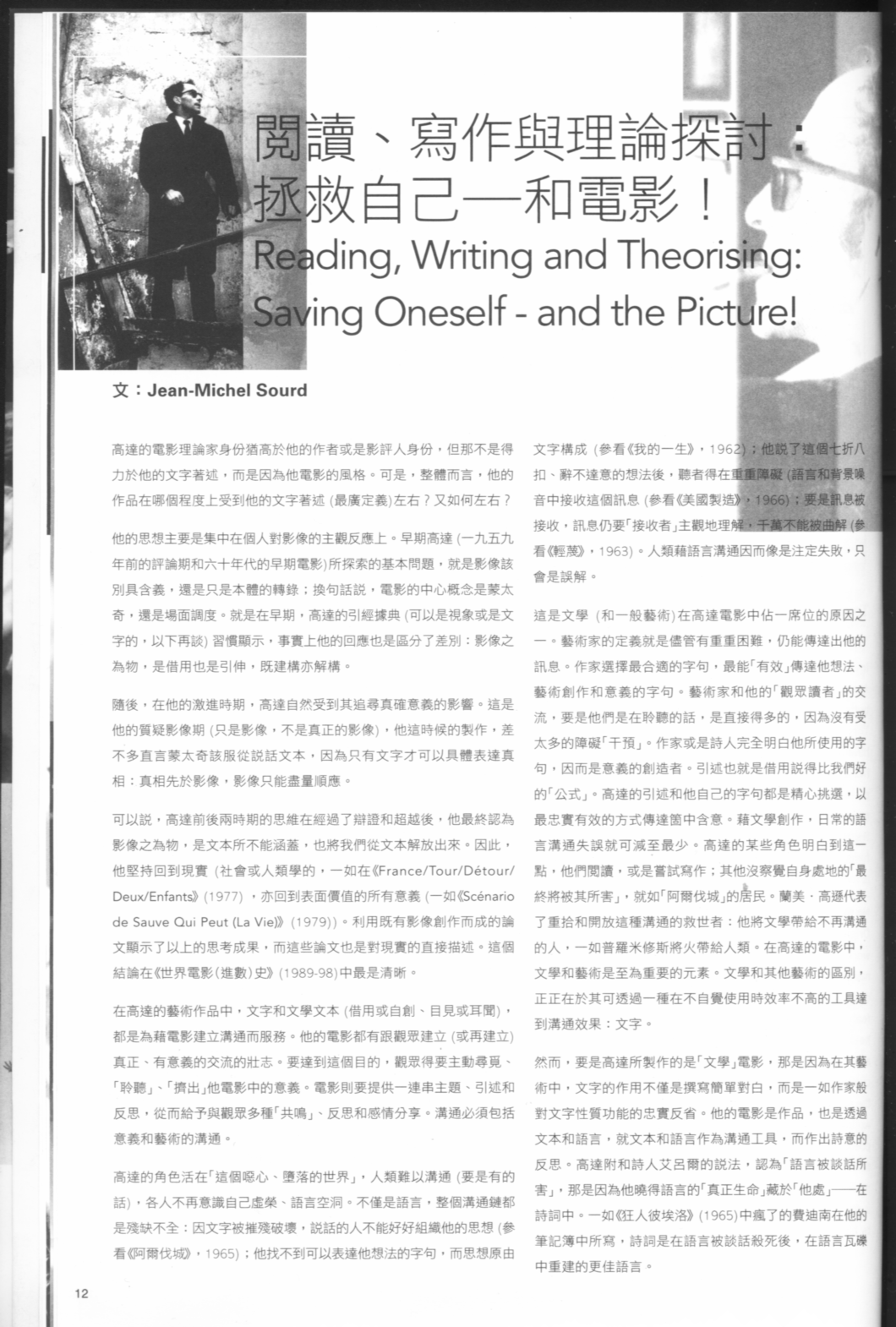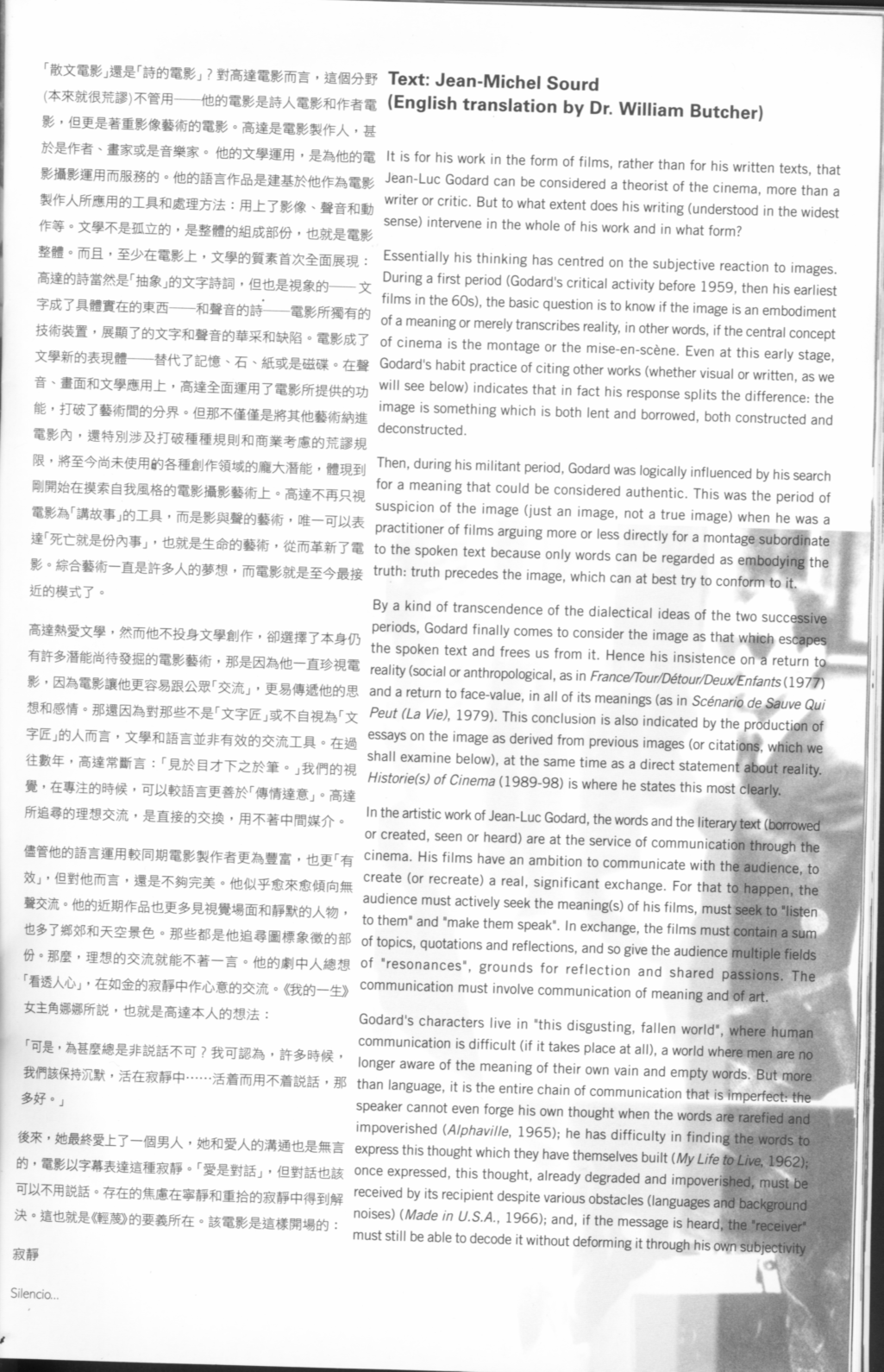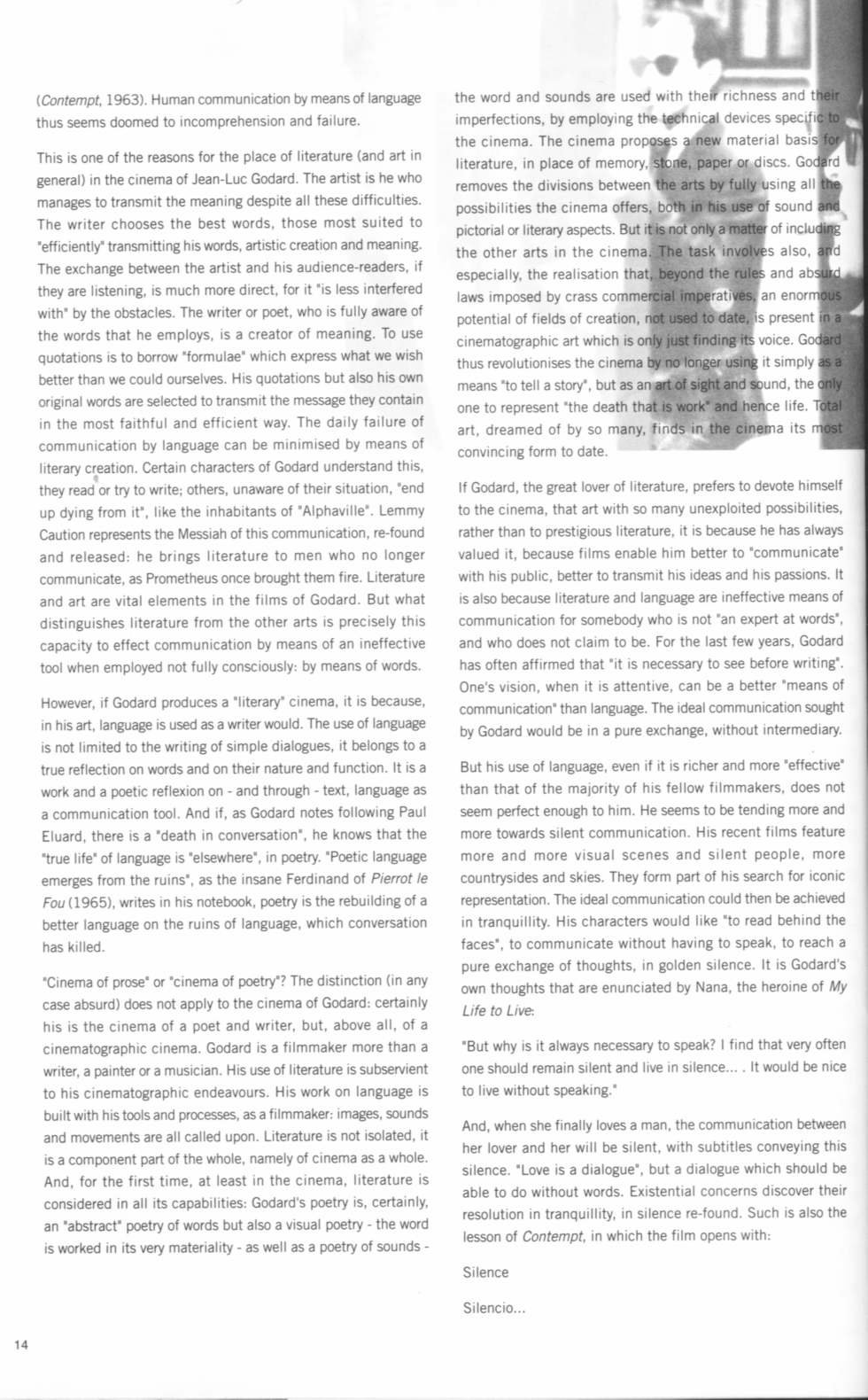Heroic Romance: Retrospective Alain Delon at the Broadway Cinematheque (Yau Ma Tei, Hong Kong) 05-16.05.2005
Everything You Always Wanted to Know About Alain Delon * But Were Afraid to Ask By Jean-Michel Sourd*
The alarm bells began ringing in earnest when the Paris courts, not content with ordering the withdrawal of books already published, slapped a ban on a book that had yet to be written. The book, an unauthorized biography of Alain Delon, the colorful film star, existed at the time, only in the form of an 18-page synopsis submitted by Bernard Violet, the author, to Grasset, the Paris publishing house, in June 1998.
French laws on delving into private lives are notoriously strict. Delon himself, about whom scurrilous stories have circulated on the Paris gossip network going back to the era of Georges Pompidou's presidency in the 1960s, is especially protective of his privacy.
More seriously, the French weekly magazine Marianne, which specializes in investigations, obtained and published the Delon lawyers ‘statement and the text of the court injunction.” Delon wanted to use the law to prevent a book being written; we are now able to let the public know what he is hiding”, said Jean-François Kahn, the chief-editor of Marianne in its August 17th issue.
In fact this incident is not only for paparazzi’ interest but also determinant in the relative strong influence that Delon’s private life got on the direction of his career.
Delon born in the South suburb of Paris, in 1935 could have become “a- nobody” or even a delinquent if he didn’t make use, at the right moment, of his charming physical appearance.
It is indeed true that he was expelled from numerous education institutions, before finally joining the French navy on the French Indo-China battle line. His bad conduct (Alain carried out a jeep of army then, he goes to a town then, he caused traffic accident so he was sent to jail) will help him to be repatriated before the conflict becomes a tragedy in 1956. This particular period of his life will be important for him because, as he said, “it helped him to be the whole person that he is now”. His passage in the navy was also symbolized by using his recognition army number as his former detective card number in his own film production and script adaptation of 1985 “Paroles de Flic”. Moreover, Alain who is suffering trouble by seasickness will have a hard time when filming “Purple Moon” with René Clément and, later for the same reason, in 1977 will reject the offer to play the character of the Captain in “Le Crabe-Tambour” directed by Pierre Schendoerffer.
Under Italian master Visconti, Delon starts to learn to be a real professional actor especially with his performance in duo with Romy Schneider, in the leading role, on the stage, in John Ford’s play “It’s a pity she’s a whore”. Visconti will become a real mentor for Delon. He will have such a fascination for him that rumors said he got a kind of love affair with him. Nevertheless, Delon will become Visconti’s protégé and Alain will never refuse the demanding work of Visconti. “Rocco and His Brothers” and “The Leopard “are still there to see Visconti’s fantastic direction of the actor. “The Eclipse”(1962) will be another chance to prove his growing talent with the demanding director Antonioni.
With the determinate goal to become a real star, his fascination for Jean Gabin since he saw him, in Saigon, on the silver screen in “Pépé Le Moko” (1937) will bring him to work with him, on “Any Number Can Win”(1963). “The Kid” (Delon) wants so much to work with “the Boss” (Gabin) that he convinced the producers, to pay him only with the benefits that the film will make abroad in Argentina, Soviet Union and Japan. The film will be such an unexpected huge success in Japan that Delon will, since then keep a status of star and will visit 9 times the country of the rising sun.
His multiple “dangerous liaisons” with women will be a constant motivation for the rising star. In 1998, he will declare in an interview :“Today, what I am, everything I am doing “ is done in order that “they (women) become proud of me”. From Romy in “The Swimming Pool” (1968) to Anne Parillaud in “For a Cop’s Hide” (1981) it’s them who will “drive” his career. Even Jean-Pierre Melville will cast Nathalie Delon in "Le Samourai"(1967) while Alain was preparing his divorce from her. In 1992, “The Return of Casanova” will give him a last chance to play, at 57 the legendary Italian seducer. What a consecration for Delon!
Delon’s involvement in so many detective stories comes surely from his encounters with Mémé Guérini and Gaetan Zampa, who were notorious Marseille gang bosses,) the knowledge he gained of their milieu, are said to have helped him portray similar characters in films such as “Borsalino” (1970) and its sequel “Borsalino & Co.” (1974) depicting the rise of this Mafia from Marseille or Le Cercle Rouge (The Red Circle).
It is difficult to reduce the complexity of the personality of Alain Delon who will stay a versatile figure of French Cinema. This particular dimension of the actor is finally captured in Bernard Violet’s book with the title “Les mystères Delon” (Delon mysteries) despite all Delon’s wish to abort it. It will become quickly, not only in France, but also in the French speaking countries around the world, a 500 pages best seller. Shortly after, in 2001, another edition in pocket size will confirm its popular success despite Alain Delon's allegation saying "the story of my life is so impossible, that no journalist would dare write it down"**
*Jean-Michel Sourd has studied Art History and Archaeology at the University of Paris 1 - Panthéon- Sorbonne. He was also a student in visual anthropology under the supervision of Jean Rouch, Hélène Puiseux and Annie Comolli at the audio-visual laboratory of the Ecole Pratique des Hautes Etudes (EPHE) at the Sorbonne while he was also attending lectures of Annie Goldman and Marc Ferro at the Ecole des Hautes Etudes en Sciences Sociales (EHESS) in Paris. He is now working as a part-time lecturer in Film Studies at HKU SPACE and he is currently a Ph. D. candidate in Sciences of Information and Communication from the University « Jean Moulin », Lyon III (France), under the supervision of Jean-Pierre Esquenazi.
**Bernard Violet (2001) “Les mystères Delon”, J’ai Lu, note 1. page 493.
© J.-M Sourd All rights reserved
  
 
 
A travers les yeux
de Chris Marker 
par Jean-Michel Sourd
PAROLES Mai/Juin 2006, No 203
Cinéaste, photographe, écrivain, poète, créateur d'installations, artiste multi média et grand voyageur, Chris Marker est une des figures les plus créatives de la culture contemporaine française. Le Hong Arts Centre lui a rendu visite à Paris et a préparé avec lui cette rétrospective choisie de ses œuvres montrée dans Le French May, tandis que le critique de cinéma Jean-Michel Sourd* nous fait partager ci-dessous son admiration pour Chris Marker.
Dans les années 80, à Paris, lorsque l'un de ces fabuleux samedis matins de la Cinémathèque Française du palais de Chaillot, le feu Jean Rouch, cinéaste, ethnologue, avec son compère, l'universitaire Xavier de France, projetaient aux étudiants réunis de Paris X— Nanterre et de la Sorbonne, l'inimitable et bouleversant film de science-fiction La Jetée, mes camarades et moi, nous entrions alors dans un moment mythique, suspendu, inoubliable. Un moment hors du temps, à l'image de ce film–ode à « L'Image-Temps » définie par Giles Deleuze en 1985 lorsqu'il enseignait lui aussi à Nanterre ses théories philosophiques du 7e Art. Théories en fait du maître Chris Marker, qui, dans la pratique les avait fait rouler 23 ans auparavant, dans le temps et l'espace de la mémoire, avant même d'être conscient d'avoir ouvert le chemin de l'osmose entre le cinéma et la philosophie.
Cet artiste et intellectuel inclassable qu'est Chris Marker a aussi marqué plus d'une génération par la bonté et la beauté pure de ses dons cinématiques. Il a engendré des graines de cinéastes, tout azimut : de la réalisatrice de documentaires Mariana Otéro au poète grec et essayiste passionné de Mondrian, Dimitris Horoskelis, en passant par des enseignants tout aussi humbles que moi, maintenant plongé dans l'analyse de la déferlante du cinéma asiatique et plus particulièrement chinois.
Chris Marker est un Godard resté dans l'ombre de la Nouvelle Vague, qui s'est refusé totalement à rentrer dans le système, qui ne s'est jamais contredit comme un Godard ou un Truffaut. Chris Marker, c'est le génie oublié de la Nouvelle Vague, à l'image d'un Philippe Soupault pour le Surréalisme, dont on a fini par mesurer l'importance de l'œuvre. Chris Marker a donné tout au long de sa carrière-caméléon, une leçon non seulement de cinéma, mais simplement de vie, à travers ses photos, ses installations, ses écrits poétiques, ses essais. La richesse de son œuvre fourmille de chefs-d'œuvre dont certains vont être projetés à Hong Kong dans le cadre du French May 2006 : La Jetée, (1962), bien sûr, ce film incontournable, voyage à travers la mémoire et le temps, mais aussi l'indéfinissable Sans Soleil réalisé 20 ans après, dans lequel une femme raconte les pensées d'un voyageur à travers ses lettres qui donnent de la terre l'impression d'une planète lointaine et sauvage. On appréciera le caractère politique de ses tranches de mémoires que sont Le fond de l'air est rouge (1977), un essai sur les guerres politiques mondiales des années 60 et 70 et sur le destin de la nouvelle gauche, et Le tombeau d'Alexandre (1993) tribut au cinéaste russe Alexandre Medvedkin et réflexion sur l'art et la politique en URSS, sans oublier ses essais « chatoyants » que sont Chat écoutant la musique (1990) et plus récemment Chat perchés (2004), ou encore la dimension de la mémoire des grands hommes comme cette Journée d'Andrei Arsenevitch (1999) qui nous dévoile l'immense talent de l'homme plein d'humilité qu'était Tarkowsky face à ses interrogations dans son œuvre testamentaire : Le Sacrifice.
La mémoire, c'est le mot-clef de Chris Marker. Il suffit d'explorer ce territoire de l'aventure de l'Image, à l'image de l'Aventure d'une vie, qu'est le CD-ROM édité en 1997 par le Centre Georges Pompidou, pour se rendre compte qu'une « visite guidée » de sa mémoire est comme celle qu'il définit lui-même « une terre de contrastes » qu'il a choisie d'appeler Immemory, ultime expérience de la mémoire que paradoxalement on n'oubliera jamais, car « Open are the double doors of Horizon, unlocked are its bolts » (Philip Glass, Aknaten, ActeI).
*Jean-Michel Sourd enseignera un cours sur la « Saga de la Guerre des Etoiles » et une« Introduction au cinéma européen » à HKU SPACE en mai 2006 et organisera.
 |
Through the Eyes of Chris Marker
15-28 May - Agnès b. Cinema, HK Arts Centre
Programmes and Timetable : www.frenchmay.com
Seminar (in English)
20, 27 May - Agmès b. Cinema
(After the screening of The Pier by Dr. Hector Rodriguez)
Exhibition: Immemory - Christ Marker
Interactive CD ROM Exhibition from Centre Pompidou
18-28 May 10:00 am - 6:30 pm
3/F Experimental Gallery, HK Arts Centre |
| |
基斯.馬爾卡的影像世界
 |
| • La Jetée (Agnès Film) |
集電影人、作家、詩人、多媒體-裝置藝術家及旅行家於一身,基斯.馬爾卡可謂當代法國藝術界最具創意的先驅之一。香港藝術中心在巴黎造訪了他,並共同策劃了將於本屆法國五月藝術節展出的他的作品精選回顧。影評人尚-米歇爾.蘇爾(Jean-Michel Sourd) 特撰此文與我們分享他對基斯.馬爾卡的景慕之情。
時為八十年代的巴黎, 在位於夏約宮的法國電影館的一個星期六早上,電影人兼人種學家尚.魯什(Jean Rouch)及其好友大學教員克札維爾(Xavier)為楠泰爾第十巴黎大學及巴黎大學的學生們放映了不可模仿的、令人震驚的科幻影片《堤》(La jetée),這真是一個如夢如幻的星期六早晨。我和同學們頓時陷入傳奇、懸疑、難忘的一刻。這一刻,時間嘎然停止了。1985年當吉爾.德勒茲在楠泰爾講授第七藝術的哲學理論時,稱這部影片是對〝影像-時間〞的頌歌。這位哲學大師的理論,早在二十三年前,基斯.馬爾 卡便在實踐中,在其回憶的時空中作了反覆思考,彼時他甚至尚未意識到自己業已開闢了電影和哲學互相滲透的通途。
基斯.馬爾卡這位藝術家,這位無以歸類的知識份子以其非凡的電影藝術天才、其作品的真、善、美影響了一代又一代人。他在全方位培育了電影藝術家,從瑪麗安娜.奧特羅(Mariana Otero)這位女紀錄片導演直至希臘詩人蒙德里安的崇拜者散文家迪米特里斯.霍洛斯克利斯(Dimitris Horoskelis),中經像我這樣一些謙卑的教學人員。在下現正專心研究亞洲電影尤其是中國電影的崛起。基斯.馬爾卡可謂新浪潮中隱身的高達,他截然拒絕歸入一種體系,但又不像高達或杜魯福,從不自相矛盾。基斯.馬爾卡如同菲利普.蘇波之於超現實主義,是新浪潮中被 人遺忘的天才,最終須從作品中衡量其份量。
在他多姿多采的藝術生涯裡,他自始至終,透過攝影、裝置藝術、詩作、評論,不僅教導人們電影藝術,更教導人們生存之義。他的藝術創作裡,佳作處處,其中一些將於今年法國五月中展出:如《堤》(1962)這部穿越回憶與時空的影片自不在話下,尚有難以歸類的、二十年後拍攝的《沒有太陽》(Sans soleil)。片中一個女人透過一個旅者的書信敘述他的思想,予人一種來自一個遙遠的蠻荒的星球的印象。《紅在革命蔓延時》(Le fond de l惊ir est rouge, 1977)則是一部史詩式的作品,描繪了六、七十年代的環球戰火及新左翼的命運。而《亞歷山大之墓》(Le tombeau d'Alexandre, 1993) 則 是對俄羅斯電影導演亞歷山大.梅德韋德金(Alexandre Medvedkin) 的惺惺相惜,並對前蘇聯的藝術和政治作了反思。還別忘了那〝閃閃發亮〞的《貓咪聽音樂》(Chat écoutant la musique, 1990)及較新近的《巴黎牆上的貓》(Chat perchés, 2004)。
《告別塔可夫斯基》(Journée d'André Arsenevitch, 1999)則是一部回憶偉人的電影,基斯.馬爾卡在片中回顧了大師遺作《犧牲》(Le sacrifice),揭示了塔可夫斯基的縱橫才氣及飽受的屈辱。回憶是基斯.馬爾卡的關鍵詞。只需探索一下由龐比杜中心1997年錄製出版的多媒體互動光碟,對這影像天地作一次如同對生活天地的探索,你便明白對他的回憶作一次〝有嚮導的探索〞,彷彿在探索他定義為〝充滿矛盾的土地〞,他亦稱之為〝不可追憶的回憶〞(Immemory),這是永遠忘不了的最高的回憶經驗,因為〝門閂業已取下,天邊那雙重大門已經洞開〞(《菲利普 .格拉斯阿克納騰》,第一幕)
註:尚-米歇爾.蘇爾將於2006年5月於香港大學校外進修學院作一次有關《星球大戰》及〝歐洲電影入門〞的演講。
|